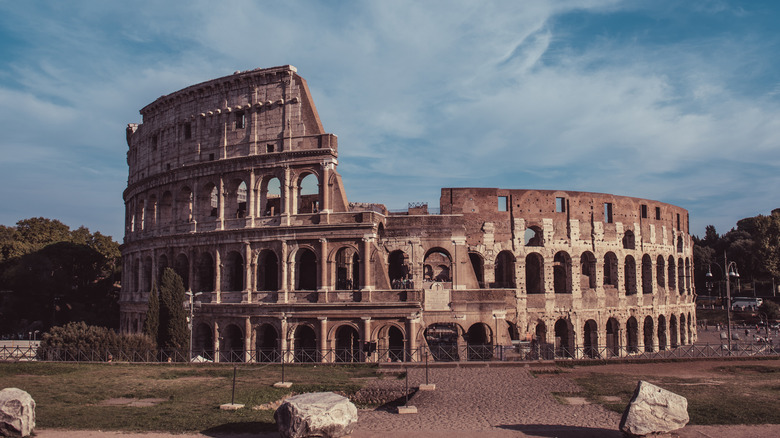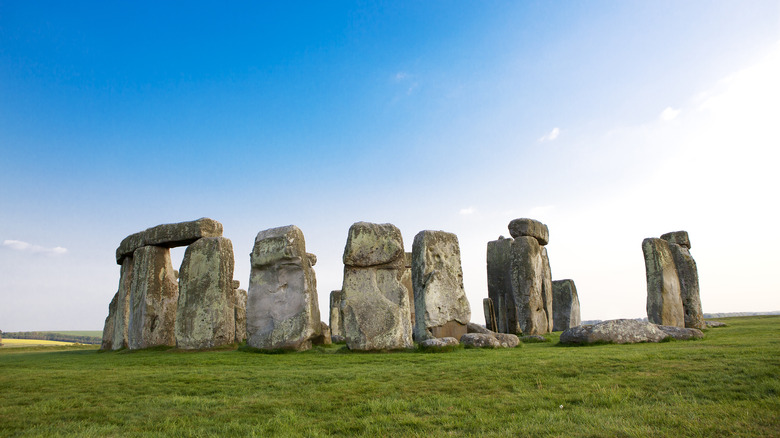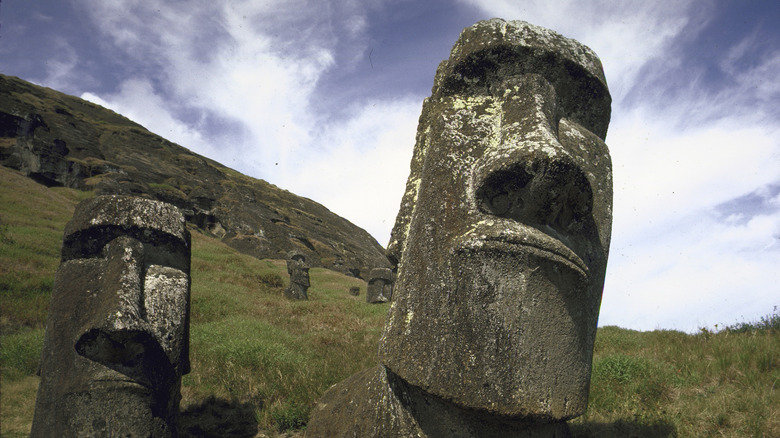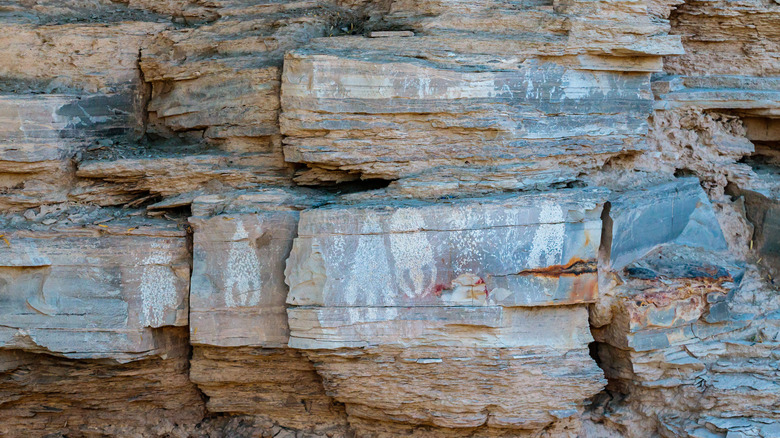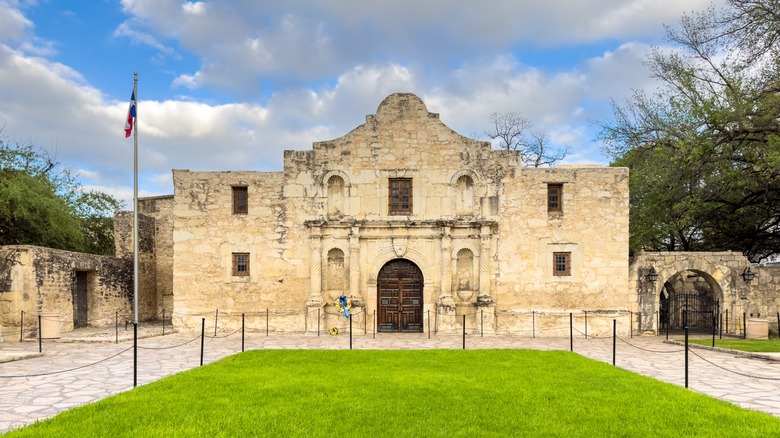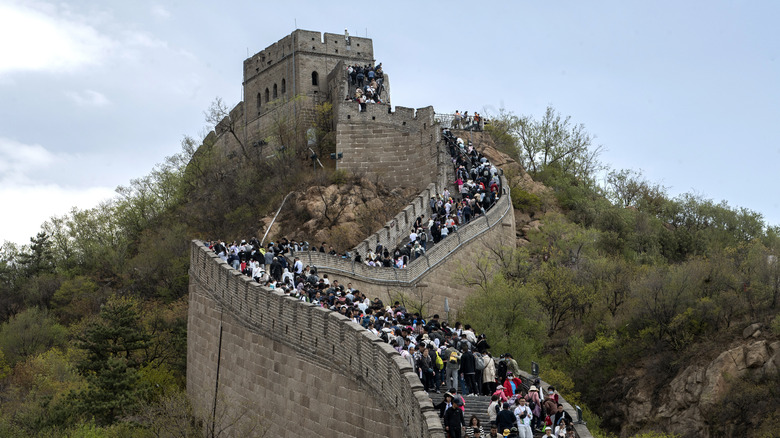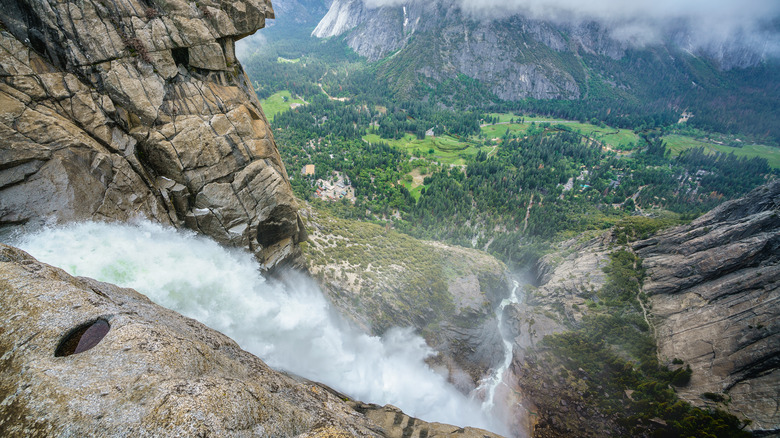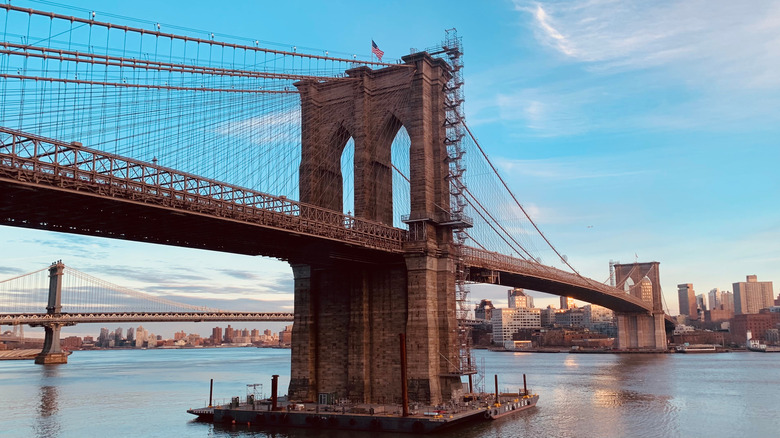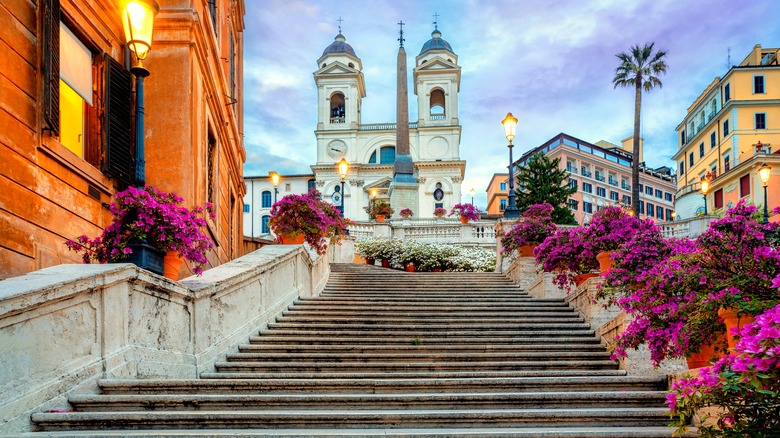Famous Things Defaced By Tourists
Around the world, there are many objects and buildings that transcend mere thing-ness and become important cultural artifacts, places that say so much about humanity and our history that losing them would be as painful as losing a loved one. Think Notre Dame burning in 2019, while the whole world watched on in horror. While that specific instance was a tragic accident, other times people attack important locations and objects on purpose. In the 2020s, this has been a tactic of climate activists, in particular, to draw attention to the plight of the Earth.
But there is another type of person seemingly hell-bent on the destruction of some of humanity's most important historic items: the tourist. The act of casually and unthinkingly defacing iconic sites is so common that the reasons behind it and the possible ways to stop it have been studied by researchers. Unfortunately, it's not as easy as it seems to get excited visitors to stop etching their names into ancient stones and buildings, because there isn't just one reason they do it — and regular crime mitigation techniques don't seem to work. "The motivating factors behind each form of vandalism need to be addressed with the help of multi-dimensional approaches," Professor Abhishek Bhati of James Cook University in Singapore explained. "It suggests that increased levels of surveillance, enforcement, and more advanced technical measures produce only temporary results."
So how bad is it? From historical tourists to modern ones, here are famous things visitors have defaced.
The Colosseum
At just under 2,000 years old, the Colosseum is an iconic building, standing out even in the history-packed city of Rome. While not everyone is an expert on ancient buildings, the Colosseum is one of those pieces of history that transcends academia, helped along by its bloody history and its inclusion in many modern films and TV shows.
However, it seems that at least one guy managed to book a trip to Rome, visit the Colosseum, and still not grasp some pretty basic facts about it. In June 2023, a British tourist was caught carving "Ivan+Hayley 23" into the walls of the historic wonder. Once the legal system got involved, he came clean about his complete ignorance of what he'd been defacing. "I admit with the deepest embarrassment that only after what regrettably happened, I learned of the antiquity of the monument," the man claimed in a letter to the court (via CNN).
But he was not alone in his need to make a literal mark on the ancient stones. July 2023 saw two teens, from Switzerland and Germany, carve their respective initials on two different days. And back in 2020, an Irishman did the same. These were only the people who got caught, of course. Archaeologist Federica Rinaldi told CNN the tourists are doing more than just physical damage, explaining, "Carving one's initials, in addition to being a crime, seems to be a gesture of those who want to appropriate the monument. Better take a selfie!"
Stonehenge
Stonehenge has been standing on Salisbury Plain in England for about 5,000 years. While people have long wondered just what it was built for (and are still in the dark about its purpose even today), that doesn't mean the monumental collection of stones has been treated kindly over the years. Before the 1600s, local residents who needed a stone for building a house or bridge might have just taken one from Stonehenge.
If anything, tourists were worse, with the ancient circle long serving as a sort of free gift shop, as long as you had a chisel. If you didn't bring your own tool, no need to worry: There were some at the site for visitors to borrow. In an 1871 edition of the archeology magazine The Antiquary, it was reported that a recent visitor to Stonehenge complained "a constant chipping of stone broke the solitude of the place." Even the famous 17th-century architect Christopher Wren, the designer of St. Paul's Cathedral, etched his name on one of the stones where it can still be seen today, much to the displeasure of English Heritage archaeologist Heather Sebire, who told The Guardian, "You'd have thought he'd have known better."
Finally, in 1900, the chisels were banned, and over the course of the 20th century, changes were slowly introduced to the site that were meant to protect the huge rocks from the millions of people who come to see them, including posting a police guard and installing barriers to keep tourists several yards away.
An Easter Island moai
The South Pacific island of Rapa Nui, also known as Easter Island, is home to the large stone heads that are properly called moai. There are estimated to be around 900 moai on the island, with more still being discovered. Some may be almost 1,000 years old.
With so many of these old and distinguished-looking heads dotting the island, it's impossible to guard all of them. Chances are if you wanted to take a piece of one of the moai home with you, there would be a time when you could do it undetected. Fortunately, that was not the case in 2008, when a local happened to catch a Finnish tourist ripping off a big chunk of a statue's ear, then taking a smaller bit and putting it in his pocket. She reported this vandalism to the police.
The tourist soon realized he was in big trouble. "He's very down and regrets what he did," the Finnish consul in Chile said, via The Independent. "He really didn't realize the magnitude of his actions." The Guardian quoted the same official as saying, "It was a sudden, impulsive crazy idea. He is sorry and surprised that it has caused such a stir." While the man's punishment ended up being a $17,000 fine and a three-year ban from the island, some wanted more. "If an ear is cut off, then an ear gets cut," the island's mayor said in an interview (via The Independent). "Eye for eye, tooth for tooth: That would be my form of justice."
Luxor Temple
Sometime around 2012 or early 2013, someone carved the Chinese characters that translate to "Ding Jinhao was here" in the 3,500-year-old Luxor Temple in Egypt. Attempts to remove the etching by temple workers had minimal success.
The first apology for the vandalism was not issued by Ding, but by a Chinese tourist who noticed the carving while on vacation and posted about it on China's Weibo social media site: "The saddest moment in Egypt. I'm so embarrassed that I want to hide myself. I said to the Egyptian tour guide, 'I'm really sorry'" (via CNN). And it was not the Egyptian government or people who railed at the vandal for what he did, but those in China, with one person labeling him "a disgrace to our entire race!" Using sleuthing skills Hercule Poirot — no stranger to Egypt-based mysteries — would be impressed with, within a day, Weibo users tracked down the culprit ... who turned out to be a middle schooler.
Considering many adults don't seem to be able to resist the temptation to leave their mark on ancient buildings, it's not surprising a young teen would make that mistake as well. In the end, his parents replied to the social media uproar for him. "We want to apologize to the Egyptian people and to people who have paid attention to this case across China," Ding's mother told her local paper, Modern Express (via China Daily).
Big Bend rock art
The colonizers of North America did a pretty horrible thing when they moved across the continent and destroyed Native people's art and history in their wake. This makes anything that did escape this steamrolling even more precious due to its scarcity. In some of the most beautiful and unpopulated areas of the U.S., many of which are now national parks, you can still find rock drawings from ancient Native tribes that are beautiful examples of early forms of artistic expression. In Big Bend on the Texas-Mexico border, these include "abstract images of geometric forms, circles, and undulating lines," Tom VandenBerg, the park's chief of interpretation and visitor services, explained to CNN.
Considering all the plain, undecorated rocks for miles around, it's inexplicable why vandals looking to carve their names would purposely choose the rocks with invaluable and irreplaceable pieces of history already carved on them 4,000-8,500 years ago. But that's just what a group of four people decided to do, adding the date they did it in 2021. "The surface scratches and discoloration are permanent," VandenBerg said. "Ancient rock art is protected, and links humanity to our past. Every site damaged is a loss to the history and heritage that national parks protects."
Nor is Big Bend the only victim. In 2016, there was a sudden increase in people vandalizing ancient carvings at Capitol Reef National Park in Utah. Park Superintendent Leah McGinnis told KUTV 2, "Once damage occurs at these remarkable works of art they can never be fully repaired."
The Alamo
While an inebriated Ozzy Osbourne urinating on the Cenotaph in front of the Alamo might be the most infamous act of (in his case, unintentional) disrespect to the iconic Texas location, other people have been more overt in their acts of vandalism there. According to reporting by KENS 5 in 2022, not only had someone tagged the Cenotaph with their name, but it was not an uncommon occurrence to find graffiti on the monument.
As for the actual building itself — which is the chapel of the larger Alamo complex that has since been destroyed — in 2015, a guide caught a tourist carving his name into the wall of the Monk's Burial Room with a key. Although he tried to flee after she confronted him, the man was quickly arrested by Alamo security and charged with second-degree felony criminal mischief for causing an estimated $250,000 worth of damage. "Many Texans died here fighting for the independence of Texas. We don't take it lightly when someone comes and desecrates this area," Chief Mark Adkins with the Alamo Rangers told KENS 5 at the time.
Similar vandalism that occurred in 2009 is more of a mystery. According to KVUE, a man from Illinois was caught carving "l-c-c" into a wall of the building, although since these were not his initials it's unclear what it meant. The man was arrested and claimed his act was part of an "art project." It's unclear what happened to him after that.
Auschwitz
You could almost — almost, mind you — come up with a reason a tourist might think it was okay, or at least not a bad thing, to do some light vandalism to the other places on this list. But there should be no amount of mental gymnastics that could possibly lead to a reason why a tourist would decide that Auschwitz, the Nazi concentration camp in Poland where more than 1 million people were systematically exterminated, was the perfect place to leave their mark.
Yet, in 2018, an Irishman saw that others had previously scratched their names onto a wall in Auschwitz, so he pulled out a coin and started to add his own, later saying he "thought it was the right thing to do" (via The Times of London). However, he was quick to take responsibility once he realized the gravity of what he'd done defacing the hallowed location. Mariusz Slomka, the deputy district prosecutor in a nearby town, said, "The man pleaded guilty. He submitted an application for voluntary submission to the penalty, and then he was released."
Perhaps even more shocking, just a few months before that incident, two Hungarian tourists were seen in the remains of one of the crematories at the site, helping themselves to bricks and putting them in their bags. Why the attempted theft from such a tragic place? "They explained that they had wanted to bring back a souvenir and didn't realize the consequences of their actions," a police press officer told the Polish Press Agency (via USA Today).
The Great Wall
When the coronavirus pandemic led to lockdowns around the world, some people seemingly forgot how to act on vacation. Once they were all allowed out again, bad behavior while traveling was rife. One place that saw inappropriate actions by tourists was China. After two months of being off-limits to visitors, in late March 2020, the country's most famous landmark invited tourists back. Soon Weibo, the Chinese social media site, saw a hashtag that translated to "Great Wall vandalized the first day it reopened" go viral (via CNN). The culprit was caught scratching something on the wall with a key, and he was fined and held for five days.
The following year, three tourists were also detained and fined for the same offense. By then, the Chinese government had already implemented new penalties to try to keep vandalism to a minimum. Effectively, they promised that anyone defacing cultural artifacts would be publicly shamed, including being placed on a blacklist that would keep them from visiting other tourist destinations. "Increasing exposure to the tourist blacklist will put more pressure on the offenders with public opinion, putting a tight chain on the tourists who ignore the rules," the state-run Beijing Daily wrote (via CNN).
Social media users certainly seemed to be in favor of this type of punishment. After the 2020 incident, one Weibo user wrote (via Singapore's Today), "Perhaps they wanted to be immortal by carving their names on the Great Wall, but now they are just infamous."
Yosemite Falls Trail
Humans are capable of creating astonishingly beautiful art, but nothing can top what nature creates all on its own. And some famously breathtaking locations, like Yosemite National Park, are so stunning that even the best artist would admit they had nothing to add to it. But in 2022, some visitors who were decidedly not talented artists thought they could pretty the place up by tagging 30 spots on the Yosemite Falls Trail with garish blue and white graffiti. Visitors and park employees alike were appalled. Park spokesperson Scott Gediman told FOX 26 News, "I mean, it's unbelievable. I think to myself, 'I was just literally on that trail a few days ago, and it's a beautiful trail, a beautiful time of year.' It just boggles the mind. How could anybody think this is okay?" While reporting indicated there were some leads in the case, it does not appear anyone was ever charged.
Nor was this the first time Yosemite was targeted with graffiti. In 2003, tags showed up on the Mist Trail that may have been gang-related. Again, it does not appear the culprits were ever found or charged with defacing the national park.
In 2020, however, a Canadian vandal who left graffiti around Death Valley National Park turned himself in, according to CNN, after discovering his messages including "Steve & Lacy Were Here" were being shared on social media in an attempt to find the culprit. Lacy was determined to be innocent of any crime, as she was the man's dog.
The Brooklyn Bridge
While most of the iconic places on this list only see the occasional tourist deciding to deface them with name carvings or graffiti, the Brooklyn Bridge in New York City is not so lucky. Perhaps because it is a bit more modern, or because it is partially made of steel, thousands of tourists have decided it's okay to scribble on it over the years.
The size of the bridge means that there's room for people to go all out with their vandalism. Messages in many languages include the basic names and dates you see everywhere, as well as poems and long messages. Some tourists add art as well, ranging from quick doodles to detailed drawings. When DNA Info heard about the large-scale defacing and went to check it out in 2013, they found a mother and daughter tourist pair writing their names and "Was Nice" in English. "We came from Holland. It's far away and we are not coming back for a long time," the daughter explained. The media outlet found vandals had drawn or written on seemingly every surface of the bridge, from beams to cables to plaques.
While you could almost see this as an accidental art project that people from all over the world contributed to, not everyone saw the potential beauty in the defacement. "That's terrible to do that," Brooklyn borough historian Ron Schweiger said. "To do it on the plaques, that's out and out vandalism."
The Spanish Steps
The 17th-century Spanish Steps are an iconic image of Rome's city center. However, 2022 was not a good year for them, tourism-wise. In June, according to a statement from Rome's cultural heritage office (via CNN), "a couple of American tourists launched a scooter three times down the steps of Trinità dei Monti, damaging the third-to-last travertine step..." And by "launched," they don't just mean rode down the steps repeatedly in the middle of the night, although that was also the case, but that the woman climbed back up the steps and then threw the scooter down them. The couple caused $27,000 worth of damage.
This incident was only amplified because it came just weeks after a Saudi tourist drove a rented Maserati down the steps, causing "widespread chippings, scratches, [and] abrasions" before abandoning the car, per CNN.
By 2023, the vandalism on the Spanish Steps, the Colosseum, and many other historic locations in Italy forced the government's hand. As well as criminal charges, damaging these sites now comes with fines of anywhere from around $11,000 to $65,000. "The attacks on monuments and artistic sites produce economic damage to all," Italian Culture Minister Gennaro Sangiuliano said in a statement (via ABC 7 News). "To clean it up, the intervention of highly specialized personnel and the use of very costly machines are needed. Whoever carries out these acts must assume also the financial responsibility."

